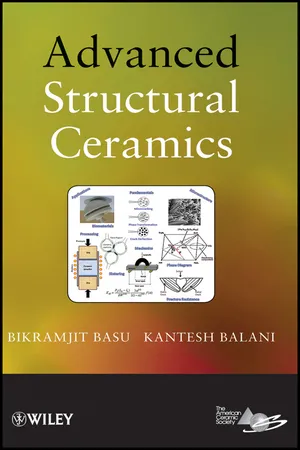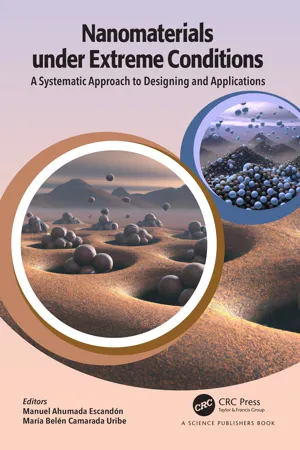Technology & Engineering
High Temperature Ceramics
High temperature ceramics are materials that can withstand extreme heat without deforming or degrading. These ceramics are used in applications such as aerospace, automotive, and industrial processes where high temperatures are present. They offer excellent thermal stability, corrosion resistance, and mechanical strength, making them essential for various high-temperature environments.
Written by Perlego with AI-assistance
Related key terms
Related key terms
1 of 4
Related key terms
1 of 3
3 Key excerpts on "High Temperature Ceramics"
- eBook - ePub
Materials Under Extreme Conditions
Recent Trends and Future Prospects
- A.K. Tyagi, S. Banerjee, A. K. Tyagi(Authors)
- 2017(Publication Date)
- Elsevier(Publisher)
Chapter 11High-Temperature Ceramics
R. Mishra, and R.S. Ningthoujam Bhabha Atomic Research Centre, Mumbai, IndiaAbstract
High temperature-ceramics are the most attractive materials used in a variety of fields such as building construction, heavy industry, nuclear industry, solid oxide fuel cells, thermal-to-electric energy conversion, and electronics and communication devices. In this chapter, recent advances in oxide-based high-temperature materials are reviewed. In the initial section, classification of ceramic materials, the nature of their bonding, phase transformations, and phase diagram are described. Details of different methods of synthesis of these materials in desired form and their properties for high-temperature applications have also been discussed.Keywords
Building construction; Furnaces; High-temperature ceramics; Properties and applications; SynthesisChapter Outline1. Introduction 2. Classification of Ceramics 3. Chemical Bonding 3.1 Madelung Constant 3.2 Lattice Energy 4. Phase Transitions 5. Phase Diagram 5.1 Magnesia–Alumina System 5.2 Alumina-Silica System 6. Preparation and Processing 6.1 Chemical Methods of Synthesis 6.1.1 Precipitation Method 6.1.2 Combustion Method 6.1.3 Sol–Gel Technique 6.1.4 Solvent-Based Synthesis 6.1.5 Hydrothermal- and Solvothermal-Based Synthesis 6.1.6 Microwave Synthesis 6.1.7 Reverse Micelle-Based Synthesis 6.1.8 Solid State Synthesis 6.2 Other Methods 6.2.1 Chemical Vapor Deposition Technique 6.2.2 Physical Vapor Deposition 6.2.3 Ball Milling or Mechanical Attrition 6.2.4 Electrolysis 6.3 Sintering Process 7. Characterization 8. Properties of Refractory Ceramics 8.1 Brittleness 8.2 Toughness 8.3 Compressive Strength 8.4 Electrical Conductivity 8.5 Vaporization of Ceramics 8.6 Thermodynamics of Nuclear Materials 9. Examples of High-Temperature Ceramics and Their Applications - eBook - ePub
- Bikramjit Basu, Kantesh Balani(Authors)
- 2011(Publication Date)
- Wiley-American Ceramic Society(Publisher)
Section Five: High-Temperature Ceramics Chapter 13 Overview: High-Temperature CeramicsThe last few decades have witnessed the development of various boride-based materials and such wider efforts are particularly due to their combination of properties, which include high hardness, elastic modulus, abrasion resistance, and superior thermal and electrical conductivity. The targeted applications include high-temperature structural materials, cutting tools, armor material, electrode materials in metal smelting, and wear parts. In this overview chapter, a review of the current state of knowledge in the development of bulk boride-based materials is presented, with particular emphasis on consolidation–microstructure–property relationships.13.1 INTRODUCTIONThe boride-based structural ceramics, because of their refractoriness and high-temperature strength, are well suited for applications at high temperature.1 Among the structural ceramics, titanium diboride (TiB2 ) is considered as the base material for a range of high-technology applications.2,3 TiB2 is a refractory material with a combination of attractive properties, including exceptional hardness (≈25–35 GPa at room temperature, more than three times harder than fully hardened structural steel), which is retained up to high temperature. It has a high melting point (>3000°C), good creep resistance, good thermal conductivity (∼65 W/m·K), high electrical conductivity, and considerable chemical stability. TiB2 also has properties similar to TiC, an important base material for cermets and many of its properties, namely, hardness, thermal conductivity, electrical conductivity, and oxidation resistance, are better than those of TiC.4–7 The unique combination of properties enables TiB2 - eBook - ePub
Nanomaterials under Extreme Conditions
A Systematic Approach to Designing and Applications
- Manuel Ahumada, María Belén Camarada, Manuel Ahumada Escandon, María Belén Camarada Uribe(Authors)
- 2023(Publication Date)
- CRC Press(Publisher)
For many processes, such as catalytic combustion, steam reforming, and industrial production, reaction temperatures are typically over 600ºC, and the thermal stability of the material becomes crucial (Zarur and Ying 2000). On the other hand, exploration of outer space requires the design of new nanomaterials resistant to high temperature and pressure. This chapter reviews some typical applications of nanomaterials in applications that need high temperatures, like industrial tools, sensors, and energetic materials. 2. Nanostructured Materials for High-temperature Applications 2.1 Heat-resistant Nanocomposites as Material for Tools The search for innovative materials is continuously developed in many applications like cutting, forming, and casting tools. The most important properties for devices are hardness, toughness, and chemical stability. These properties are relevant in machining operations on hard and tough materials, especially in extreme conditions like interrupted cutting, high-speed cutting, and dry cutting operations. In particular, dry machining is of enhanced research interest because of its environmental benefits. However, the high heat generation during the process may weaken the desirable tool properties leading to failure. Up to date, one of the available solutions with the best results is the modification of surfaces through the deposition of protective coatings to improve tools and components’ lifetime and performances (Gekonde and Subramanian 2002, Mitterer et al. 2000, Sandstrom and Hodowany 1998). Therefore, the oxidation resistance of protective coatings at elevated temperatures becomes a critical focus of interest. Due to the high hot hardness and toughness, mixed alumina is suitable for hard machining purposes (Arunachalam et al. 2004). Ceramics can be mixed with alumina, but vibrations and forces may affect the final behavior (Aslantas et al
Index pages curate the most relevant extracts from our library of academic textbooks. They’ve been created using an in-house natural language model (NLM), each adding context and meaning to key research topics.
Explore more topic indexes
Explore more topic indexes
1 of 6
Explore more topic indexes
1 of 4


